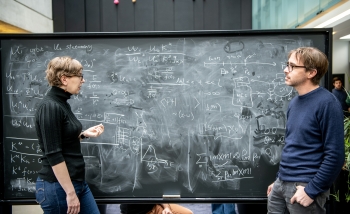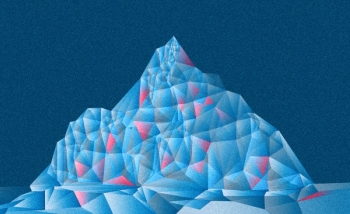Physicists seeking to craft a theory of quantum gravity face a major challenge: the two theories they hope to unite don’t talk to each other.
Quantum theory, which explains nature at the atomic and subatomic level, uses discrete microscopic building blocks. General relativity deals with the sweeping continuum of spacetime on large scales.
Scientists hoping to knit the two together into a “theory of everything” are facing vastly different scales. Worse: the numerical tools currently at their disposal cannot bridge the divide between the quantum “discretuum” and the macroscopic “continuum.”
“This is a problem that needs to bridge many scales, which is always difficult in physics,” says Perimeter Institute Faculty member Bianca Dittrich. “Any approach to quantum gravity starts off with a fundamental model. But if you’re asked to show how the model explains the world, there aren’t many tools to do that.”
While many physicists are well versed in the math required, often they aren’t as familiar with the numerical techniques. That’s because, frankly, numerics just isn’t as popular as its friend, analytics.
But Dittrich and Perimeter Distinguished Visiting Research Chair Renate Loll are hoping to change that. Together, they are establishing the From Discretuum to Continuum (D2C) Research Initiative, an effort to bring more people inside the numerics tent.
“Most students don’t want to do numerics,” says Dittrich. “It’s not cool. For me, it was actually the same thing. But I came to a point where I had to solve a problem, and I had to learn it and do it numerically.”
That, she says, is a common story: “It’s always the main problem – you can do so much with good ideas, but many approaches get somehow stuck at this point. It would be good to have better tools.”
The From D2C Initiative aims to raise the level of numerical ability among physicists, and to help create a universal tool that can be applied to a number of proposed approaches to quantum gravity. That would not only help assess the approaches, but also help work out which approaches to pursue and which to exclude.
The first workshop of the initiative is now being planned for late September at Perimeter Institute. Dittrich and Loll are inviting postdoctoral researchers who might be interested in learning and applying new techniques.
“Many people see the problem, but there’s something like a wall in front of them, which is to learn these methods,” Dittrich said. They hope the workshop, and the ongoing research initiative, will be the first step in breaking down that wall.
Further exploration
À propos de l’IP
L'Institut Périmètre est le plus grand centre de recherche en physique théorique au monde. Fondé en 1999, cet institut indépendant vise à favoriser les percées dans la compréhension fondamentale de notre univers, des plus infimes particules au cosmos tout entier. Les recherches effectuées à l’Institut Périmètre reposent sur l'idée que la science fondamentale fait progresser le savoir humain et catalyse l'innovation, et que la physique théorique d'aujourd'hui est la technologie de demain. Situé dans la région de Waterloo, cet établissement sans but lucratif met de l'avant un partenariat public-privé unique en son genre avec entre autres les gouvernements de l'Ontario et du Canada. Il facilite la recherche de pointe, forme la prochaine génération de pionniers de la science et communique le pouvoir de la physique grâce à des programmes primés d'éducation et de vulgarisation.
Ceci pourrait vous intéresser



